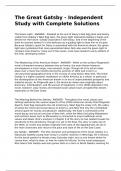The Great Gatsby - Independent
Study with Complete Solutions
The Green Light - ANSWER - Situated at the end of Daisy's East Egg dock and barely
visible from Gatsby's West Egg lawn, the green light represents Gatsby's hopes and
desires for the future. Gatsby associates it with Daisy, and in the beginning of the
book he reaches toward it in the darkness as a guiding light to lead him to his goal.
Because Gatsby's quest for Daisy is associated with the American dream, the green
light also symbolizes that more generalized ideal. Nick also uses the green light to
compare how America, rising out of the ocean, must have looked to early settlers of
the new, developing nation.
The Weakening of the American Dream - ANSWER - While on the surface Fitzgerald's
novel a thwarted romance between two ex-lovers, the main theme however,
encompasses a much larger, less romantic scope. Though all of its action takes
place over a mere few months during the summer of 1922 and is set in a
circumscribed geographical area in the vicinity of Long Island, New York, The Great
Gatsby is a highly symbolic meditation on 1920s America as a whole, in particular
the disintegration of the American dream in an era of unprecedented prosperity and
material excess. As Fitzgerald saw it, the American dream was originally about
discovery, individualism, and the pursuit of happiness. In the 1920s depicted in the
novel, however, easy money and relaxed social values have corrupted this dream,
especially on the East Coast.
The Meaning Behind the Setting - ANSWER - Throughout the novel, places and
settings epitomize the various aspects of the 1920s American society that Fitzgerald
depicts. East Egg represents the old aristocracy, West Egg the newly rich, the valley
of ashes the moral and social decay of America, and New York City the uninhibited,
amoral quest for money and pleasure. Additionally, the East is connected to the
moral decay and social cynicism of New York, while the West (including Midwestern
and northern areas such as Minnesota) is connected to more traditional social
values and ideals. Nick's analysis in Chapter 9 of the story he has related reveals his
sensitivity to this dichotomy: though it is set in the East, the story is really one of
the West, as it tells how people originally from west of the Appalachians (as all of
the main characters are) react to the pace and style of life on the East Coast.
Jay Gatsby - ANSWER - The title character and protagonist of the novel, Gatsby is a
fabulously wealthy young man living in a Gothic mansion in West Egg. He is famous
for the lavish parties he throws every Saturday night, but no one knows where he
comes from, what he does, or how he made his fortune. As the novel progresses,
Nick learns that Gatsby was born James Gatz on a farm in North Dakota; working for
, a millionaire made him dedicate his life to the achievement of wealth. When he met
Daisy while training to be an officer in Louisville, he fell in love with her. Nick also
learns that Gatsby made his fortune through criminal activity, as he was willing to
do anything to gain the social position he thought necessary to win Daisy. Nick
views Gatsby as a deeply flawed man, dishonest and vulgar, whose extraordinary
optimism and power to transform his dreams into reality make him "great"
nonetheless.
Nick Carraway - ANSWER - The novel's narrator, Nick is a young man from
Minnesota who, after being educated at Yale and fighting in World War I, goes to
New York City to learn the bond business. Honest, tolerant, and inclined to reserve
judgment, Nick often serves as a confidant for those with troubling secrets. After
moving to West Egg, a fictional area of Long Island that is home to the newly rich,
Nick quickly befriends his next-door neighbor, the mysterious Jay Gatsby. As Daisy
Buchanan's cousin, he facilitates the rekindling of the romance between her and
Gatsby. The Great Gatsby is told entirely through Nick's eyes; his thoughts and
perceptions shape and color the story.
Weather - ANSWER - Much like Shakespeare, Fitzgerald often set the mood of a
scene by describing the weather. Gatsby and Daisy's reunion begins amid a pouring
rain, proving awkward and melancholy; their love reawakens just as the sun begins
to come out. Gatsby's climactic confrontation with Tom occurs on the hottest day of
the summer, under the scorching sun (like the fatal encounter between Mercutio
and Tybalt in Romeo and Juliet). Wilson kills Gatsby on the first day of autumn, as
Gatsby floats in his pool despite a palpable chill in the air—a symbolic attempt to
stop time and restore his relationship with Daisy to the way it was five years before,
in 1917.
"He had one of those rare smiles with a quality of eternal reassurance in it, that you
may come across four or five times in life. It faced, or seemed to face, the whole
external world for an instant and then concentrated on you with an irresistible
prejudice in your favor. It understood you just as far as you wanted to be
understood, believed in you as you would like to believe in yourself."
+
"I was standing beside his bed and he was sitting up between the sheets, clad in his
underwear, with a great portfolio in his hands.
"Beauty and the Beast...Loneliness...Old Grocery House...Brook'n Bridge...."




